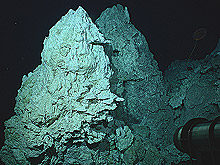The tallest hydrothermal vent is the 60 m (180 ft) tall carbonate PoesidonPoseidon vent, amongstamong the Lost City hydrothermal vent system on top of the ~4km high Atlantis Massif, located 20 km west of the Mid-Atlantic Ridge at 30°N. The vents emit pH 9-11 metal-poor fluids at about 90°C.
The composition of the hydrothermal vents are aragonite, calcite (both polymorphs of calcium carbonate, $\ce{CaCO3}$), and brucite ($\ce{Mg(OH)2}$) giving the white colour of the vents, the pinnacle of the Poseidon vent is shown below:

The Lost City hydrothermal vents are discussed in detail in the University of Washington's Lost City Research and NOAA's Formation of Carbonate Chimneys at the Lost City Hydrothermal Field page, from the websites, in answer to your questions:
Age: presumed to be over 30,000 years old.
What contributes to its height: Asides from the age of the vents, which allows the vents to build up. The vents are formed on a base of thick fossiliferous pelagic limestone, which form an impervious lid trapping the hydrothermal fluids and geothermal heat.
This limestone overlies a sedimentary breccia, which overlies fractured and faulted basement of highly deformed serpentites and exposed Mg-rich mantle rocks (peridotites).
Biomass: It is believed that 58% of the fauna are endemic to the Lost City environment, including the Lost City Methanosarcinales inhabiting the anoxic interior zones of the vent, which are an example of Methane- and Sulfur-Metabolizing Microbial Communities Dominate the Lost City Hydrothermal Field Ecosystem (Brazelton et al. 2006). Observations suggest that $\ce{CH4}$ and $\ce{S}$ cycling dominate the ecological processes in the Lost City vent environment.